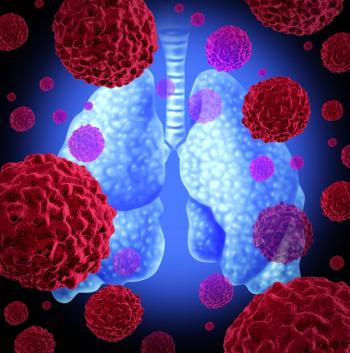
Oncology NEWS International
- Oncology NEWS International Vol 11 No 1
- Volume 11
- Issue 1
80 Gy Radiotherapy After Chemotherapy Is Feasible in Lung Cancer
SAN FRANCISCO-Patients with inoperable, locally advanced lung cancer can tolerate up to 80 Gy of conformally delivered radiation therapy, given in 1.6 cGy fractions twice daily, following carboplatin (Paraplatin)/paclitaxel (Taxol) or carboplatin/vinorelbine (Navelbine), according to a phase I study presented at the 43rd Annual Meeting of the American Society for Therapeutic Radiology and Oncology (abstract 35).
SAN FRANCISCOPatients with inoperable, locally advanced lung cancer can tolerate up to 80 Gy of conformally delivered radiation therapy, given in 1.6 cGy fractions twice daily, following carboplatin (Paraplatin)/paclitaxel (Taxol) or carboplatin/vinorelbine (Navelbine), according to a phase I study presented at the 43rd Annual Meeting of the American Society for Therapeutic Radiology and Oncology (abstract 35).
In this dose-escalation trial, 36% of patients had a complete or partial response after receiving both chemotherapy and radiotherapy.
"We wanted to find the maximally tolerated radiation therapy dose," said Julian Rosenman, MD, professor of radiation oncology, University of North Carolina (UNC) at Chapel Hill. The patients in the trial, however, did not undergo concurrent therapy, because the study was designed before this treatment method was proved effective. "We thought that if we could give very high doses of radiation, perhaps concurrent therapy wasn’t necessary," Dr. Rosenman said.
The study was performed by researchers at UNC, Duke University, Wake Forest University, and the Medical University of South Carolina. Between November 1997 and March 2001, 39 patients with a median age of 59 were enrolled; 61% were male and 39% were female. The size of their tumors ranged from 1 to 11 cm. Patients had stage IIB lung cancer (3%), stage IIIA (64%), or stage IIIB (33%).
Patients were enrolled in cohorts of seven, with the first seven receiving carboplatin/paclitaxel and the second seven carboplatin/vinorelbine. The two arms were evaluated separately in order to assess the impact of the induction regimen on the rate of grade 3 toxicity and, thus, the maximum tolerated dose.
Thirty-seven patients completed their chemotherapy regimen. After chemotherapy, 17 had a partial response, 12 had no response, 6 progressed, and 2 could not be evaluated.
Both groups of patients received radiation doses starting at 73.6 Gy, and escalating in 6.4 Gy intervals to 80 and 86.4 Gy. An earlier trial had successfully tested doses up to 74 Gy in patients who received chemotherapy, Dr. Rosenman said.
At 80 Gy, one patient in each group sustained complications of grade 3 esophagitis. When the carboplatin/paclitaxel patients received radiation doses of 86.4 Gy, two sustained an unusual and serious side effectbronchopleural fistulas. The patients’ bronchi broke down and underwent necrosis, leaving them vulnerable to infections. "This complication was very frightening, and because of it, this section of the trial was stopped. We found that the high-dose therapy of 86 Gy was not safe," Dr. Rosenman said.
One explanation for the bronchi necrosis may have been that both patients who experienced it had very large tumors, he said. They both had cancer in 20% to 35% of their lungs. After their complications were resolved, however, at least one of these two patients did well. That patient is disease-free a year and a half after treatment. Dr. Rosenman commented that "86 Gy is a lot of radiation, but perhaps this is what it took to cure her."
The study is still ongoing, and enrollment in the carboplatin/vinorelbine arm continues. The researchers intend to give 86.4 Gy of radiation to the carboplatin/vinorelbine group and, if that dose is safe, to progress to 92.8 Gy.
"Our study leads us to conclude that you can go up to 80 Gy in a twice-daily fashion safely and not get any serious complication but grade 3 esophagitis," Dr. Rosenman said.
There were no other significant side effects such as radiation pneumonitis, he said. "When the lung is dead, hitting it again and again with radiation doesn’t affect it," he said. "Pneumonitis is a problem of volume, not of dose."
In the study, 5 patients (13%) had a complete response and 6 patients (23%) had a partial response after both radiation therapy and chemotherapy. The median survival was only 16.2 months, a result that Dr. Rosenman found disappointing. In the previous trial of 74 Gy of radiation therapy after chemotherapy, he noted, the median survival was 14 months.
"The fact that the median survival was not all that impressive suggests that the concurrent use of chemotherapy and radiation may be necessary, even when radiation doses are quite high," Dr. Rosenman said.
One- and 2-year survival rates in this trial were 67% and 39%, respectively. Of the 12 patients with evidence of tumor regrowth, six had a local failure in the high-dose volume, six had a regional failure outside of the high-dose volume, and five had distant metastatic disease, Dr. Rosenman said.
The researchers elected not to use amifostine (Ethyol) to protect against complications in this trial. "However, considering the new research that is now being released about amifostine, we may soon change our minds," Dr. Rosenman said.
Articles in this issue
almost 24 years ago
ODAC Sends Mixed Message on New Gliadel Wafer Indicationabout 24 years ago
ONCC Certification Test Results Are Announcedabout 24 years ago
Rituximab Ups Survival in Aggressive and Indolent NHLabout 24 years ago
Topotecan Used in Aggressive Front-Line Therapy for SCLCabout 24 years ago
Depsipeptide Shows Activity in T-Cell Lymphomaabout 24 years ago
FDG-PET Useful in Newly Diagnosed and Recurrent NSCLCabout 24 years ago
ODAC Backs Adding HER-2 DNA Test to Herceptin Package Insertabout 24 years ago
FDA and VA Plan Joint AIDS Studyabout 24 years ago
Breast Conservation Increases With On-Site Radiation UnitNewsletter
Stay up to date on recent advances in the multidisciplinary approach to cancer.































































































